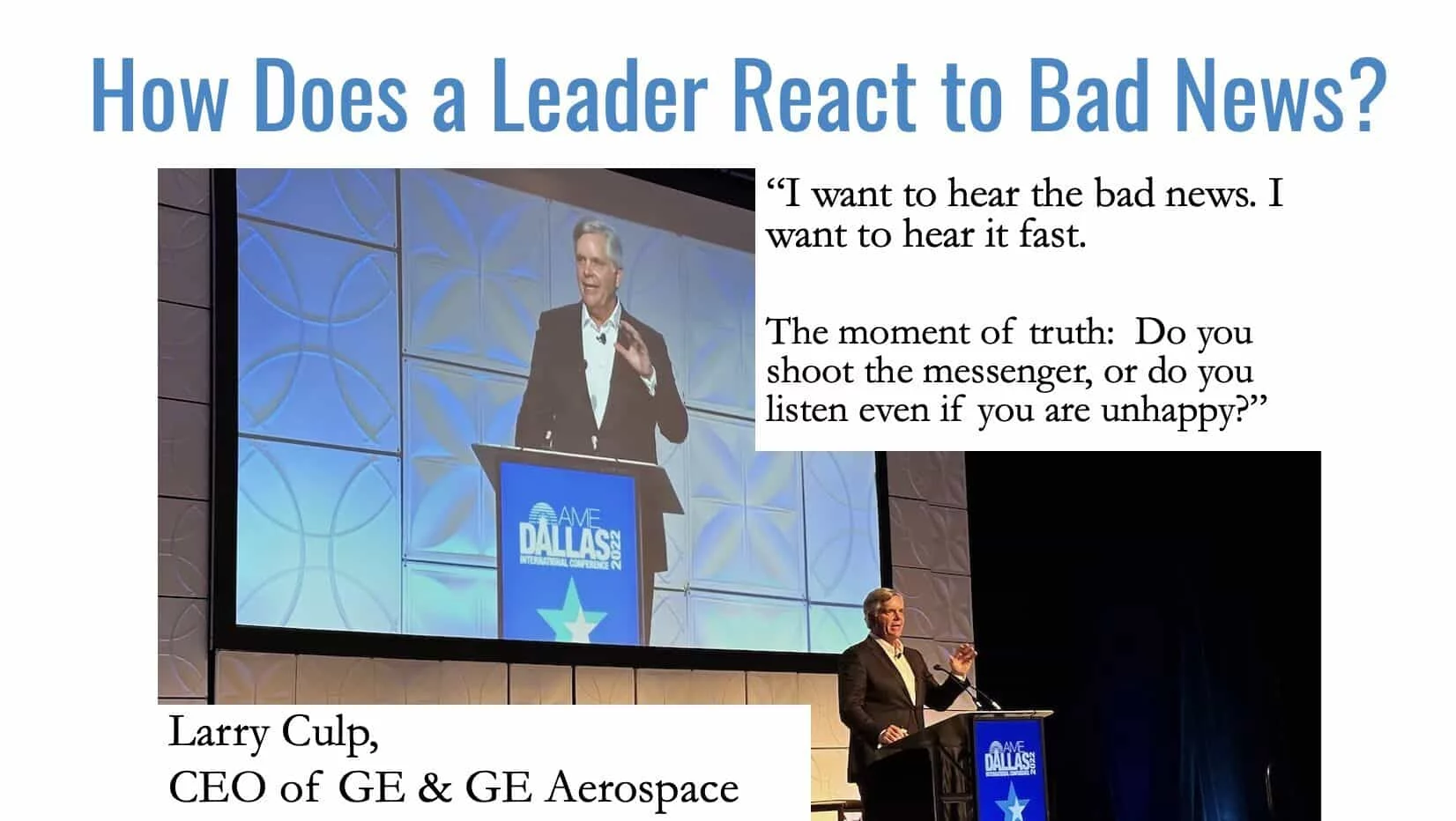Making it Safe for Bad News to Flow to the CEO (or Other Leaders)
Following up on my blog post about GE CEO Larry Culp's AME keynote speech, I wanted to share some of the discussion from his “fireside chat, absent the fire” (as Larry called it) with Katie Anderson (as we discussed in our podcast episode).
Larry observed that, as a second-time CEO, he has to be aware that:
“Bad news does not typically travel fast. People can be overly deferential.”
Is that a problem in your organization?
Timothy R. Clark, the author of The 4 Stages of Psychological Safety, talks about the need for leaders to react constructively to bad news. Doing so builds psychological safety when people are rewarded for the vulnerable act of bringing bad news forward.
Hear Mark read this post — subscribe to Lean Blog Audio
Katie asked Larry a question to dig deeper into the flow of bad news:
“I wanna go back to this concept of bad news and having a culture where it's okay to have failures, to have mistakes, and to learn from them. How do you, how important do you think it is to build that into your leadership practice and culture?”
Larry replied:
“Well, I've seen a number of examples over my career where bad news has not traveled fast — and it can be fatal.”
He shared an example from his time as CEO of Danaher, where they acquired many companies. As he visited one company:
“I remember vividly somebody saying, during the course of due diligence, ‘We no longer talk about bad news. It has been deemed bad for morale.'”
Would you run away screaming at this sign of a bad culture? Larry leaned in… since it had great technology and great people:
“… if that's been the mindset, this company can be turned around, right? ‘Cause we'll let the bad news in. We'll deal with that reality. We'll work those problems.”
My takeaway from that anecdote is that culture can be changed. The ability to change the culture can be a competitive advantage for leaders who know how to do so.
The flow of bad news must lead to problem solving — “we'll work those problems.” If we make it psychologically safe for employees to speak it up, leaders also need to make sure it's worth their while to do so.
Even if we eliminate fear, we have to also eliminate another f-word: futility (as we've learned from the research of Ethan Burris):
Katie asked another follow-up question:
“So how did you start fostering that environment that made it okay to share maybe the imperfections or the challenges, the mistakes?”
Larry replied:
“Katie, I think it's largely about how you deal with bad news, right?
I can encourage all of you to come to me if we were working together: I want to hear the bad news. I want to hear it fast.”

As he then said, Larry realizes that saying this doesn't mean it's automatically going to happen. But, somebody will test the waters to see if it's really safe and if he walks the talk.
“But a week or two will pass, somebody will have some issue, and that will be the moment of truth, right? Do you shoot the messenger, or do you listen even if you are unhappy?”
The moment of truth, indeed.
Larry saw the opportunity to change the culture at GE, where, as he recalled that there was a perception that messengers were shot.
If the leader can react to problems or other bad news well:to
“And do you then go into problem solving mode, right? Both to contain [the problem] and to deal with root cause. That's a lot easier said than done.”
You can't get into problem solving mode if you don't make it safe for people to speak up. Larry recalled a situation where:
“I had a sense that there was bad news brewing. I could see somebody almost trembling. And we had a great conversation.
He had the confidence, the fortitude, the trust to bring it forward. We had a really good discussion about it, painful for all of us.
We ultimately, I think, dealt with the issue, but it was the beginning for us, at least for the broader team, to see that I could walk that talk. I could handle bad news. I would not shoot messengers.”
Somebody was brave. They tested the psychological safety of the situation. And it sounds like that was rewarded by Larry as the leader.
- He could walk the talk
- He could handle bad news
- He would not shoot messengers
I'll write a separate blog post about this, I think, but take a moment to reflect on all of the “Lean tools” or methods from Toyota that would not work without psychological safety… without the safety to acknowledge the real reality, without the safety to point out problems.
Toyota explicitly talks about building psychological safety, as I wrote about recently:
Larry said they haven't completely turned that culture at GE. I'd add that culture change takes time, it's not like flipping a light switch.
“I'm not sure we ever necessarily achieved perfection in that regard at Danaher,” he added.
But creating the culture goes beyond the CEO:
“…any of us, again — it's not a CEO thing — any of us have the opportunity to create that environment where people want to bring forward an issue and, and know they're gonna get help. They won't be chastised.”
How powerful would this culture be in your organization? How helpful would it be in a healthcare organization?? How can we help create more of this?
What do you think? Please scroll down (or click) to post a comment. Or please share the post with your thoughts on LinkedIn – and follow me or connect with me there.
Did you like this post? Make sure you don't miss a post or podcast — Subscribe to get notified about posts via email daily or weekly.
Check out my latest book, The Mistakes That Make Us: Cultivating a Culture of Learning and Innovation:









